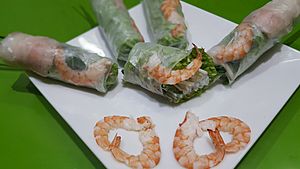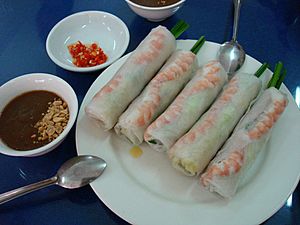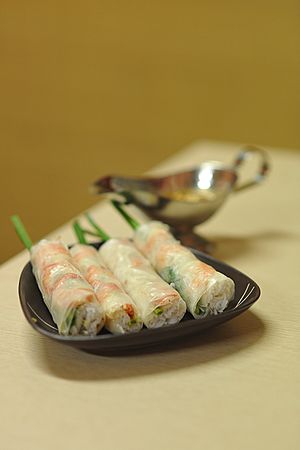Gỏi cuốn facts for kids

Gỏi cuốn wrapped in Vietnamese bánh tráng
|
|
| Alternative names |
|
|---|---|
| Course | Hors d'oeuvre |
| Place of origin | Vietnam |
| Region or state | Southeast Asia |
| Serving temperature | Room temperature |
| Main ingredients |
|
Gỏi cuốn (pronounced "goy koon"), also known as fresh spring rolls or summer rolls, is a popular and tasty dish from Vietnam. These rolls are filled with delicious ingredients like pork, prawns, fresh vegetables, and bún (rice vermicelli noodles). Everything is carefully wrapped in thin Vietnamese bánh tráng, which is a special kind of rice paper.
Unlike many other spring rolls that are fried, gỏi cuốn are served fresh and cool. They are not deep-fried or cooked on the outside, making them a light and refreshing choice. People often enjoy them as a starter or appetizer in Vietnamese restaurants.
Contents
Making Gỏi Cuốn: A Fresh Roll Recipe
How to Prepare Your Own Summer Rolls
Making gỏi cuốn is quite simple! First, a piece of bánh tráng (rice paper) is briefly dipped in water to make it soft. Then, it's laid flat on a plate. You then place your favorite ingredients, like cooked pork, shrimp, fresh lettuce, and rice noodles, on top.
Next, you carefully roll up the rice paper, tucking in the sides to create a neat, tight roll. Once rolled, your fresh gỏi cuốn is ready to eat!
Delicious Dipping Sauces for Gỏi Cuốn
Gỏi cuốn tastes even better with a dipping sauce. One popular choice is tương xào, a rich sauce made from ground tương (a type of bean paste). This sauce is often cooked with coconut water or broth, garlic, and a little sugar, then topped with chili powder and crushed peanuts.
Another common and very popular option is peanut sauce, which is creamy and savory. You can also dip gỏi cuốn in nước chấm, a famous Vietnamese condiment made mainly from fish sauce. Each sauce adds a different flavor to the fresh rolls.
Traditional Ways to Enjoy Gỏi Cuốn
In Vietnam and other parts of Southeast Asia, people often make bánh tráng (rice paper) by hand. You might see the thin sheets drying on rectangular bamboo trays around homes. Traditionally, gỏi cuốn is a dish that families and friends enjoy together. It's often prepared and eaten in a group setting at home, making it a fun and social meal.
Names for Gỏi Cuốn Around the World
Different Names in Vietnam
The name for these fresh rolls can change depending on where you are in Vietnam. In southern Vietnam, they are called gỏi cuốn, which means "salad rolls." But if you go to northern Vietnam, people usually call them nem cuốn, meaning "nem rolls." In central Vietnam, they are sometimes simply called "rice paper" rolls.
English Names for Gỏi Cuốn
In Western countries, these rolls have many different English names. You might hear them called "salad rolls," "spring rolls," or "summer rolls." Sometimes, people add "Vietnamese" to the name, like "Vietnamese spring rolls" or "Vietnamese cold rolls." For example, in Hong Kong, they are known as "Vietnamese rolls," and in Australia and the United States, they might be called "Vietnamese spring rolls" or "cold rolls."
Some restaurants in the United States also use names like "crystal rolls," "soft rolls," or "salad rolls." The name "summer roll" became popular because it sounds fresh and is a fun play on the term "spring roll," especially for marketing. However, many Vietnamese American restaurants still use "spring roll" as the English translation.
Gỏi Cuốn in Other Countries
It's easy to tell fresh gỏi cuốn apart from other fried rolls because they are not cooked with oil. Also, the ingredients inside are usually different from fried Vietnamese egg rolls.
In Cambodia, Vietnamese gỏi cuốn are called nime chao, which means "raw rice paper." They are made using a slightly different method in areas like Siem Reap and Battambang. In Japan, these rolls are known as nama harumaki (生春巻き), meaning "raw spring rolls," and they are often filled with shrimp.
Variations of Gỏi Cuốn Fillings
The fillings for gỏi cuốn can be very creative! While the classic rolls have pork slices, pork sausage (chả), and shrimp, there are many other tasty options.
You might find rolls filled with fish, pan-fried seafood like squid, or beef cooked in a flavorful lemongrass broth. For vegetarians, there are delicious versions with tofu. Other popular choices include grilled nem nướng sausages, tender braised pork, or even egg. These different fillings make gỏi cuốn a versatile and exciting dish to try!
See also
 In Spanish: Rollo de verano para niños
In Spanish: Rollo de verano para niños



